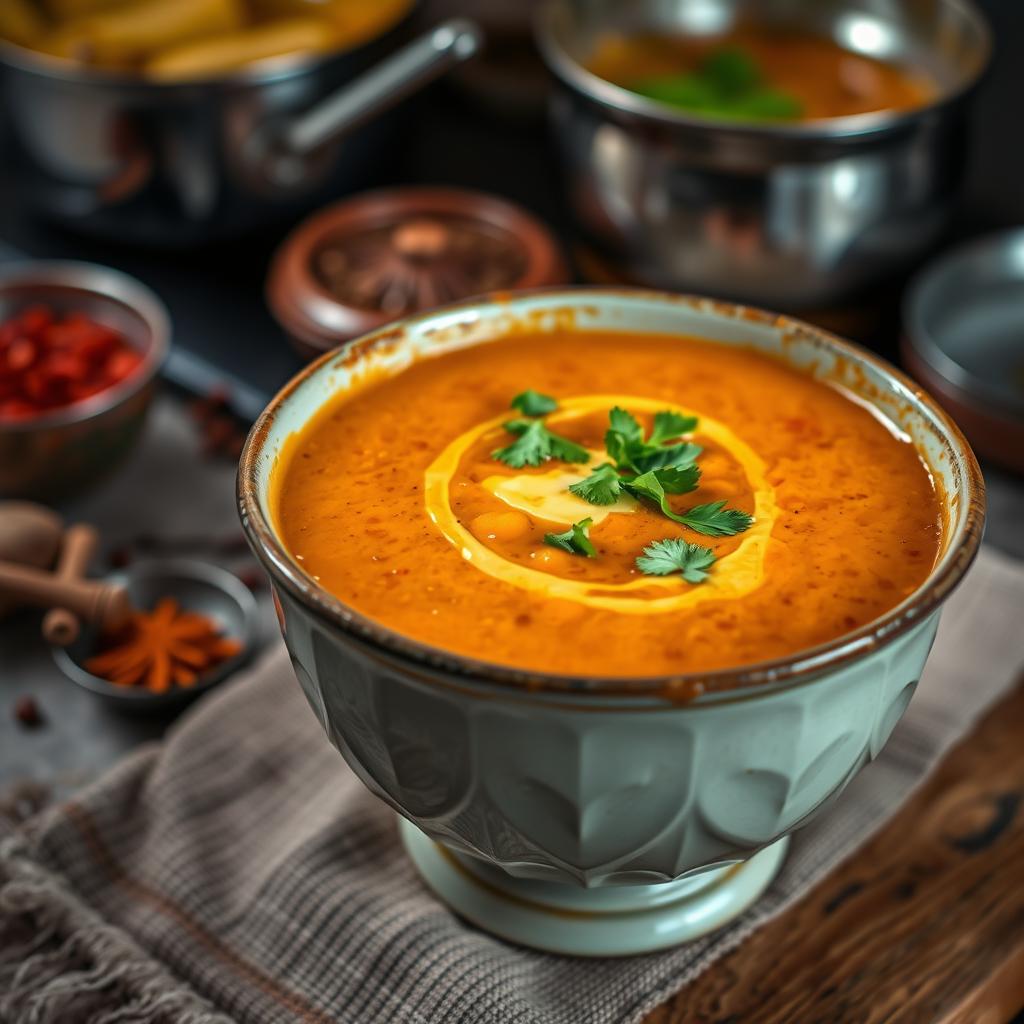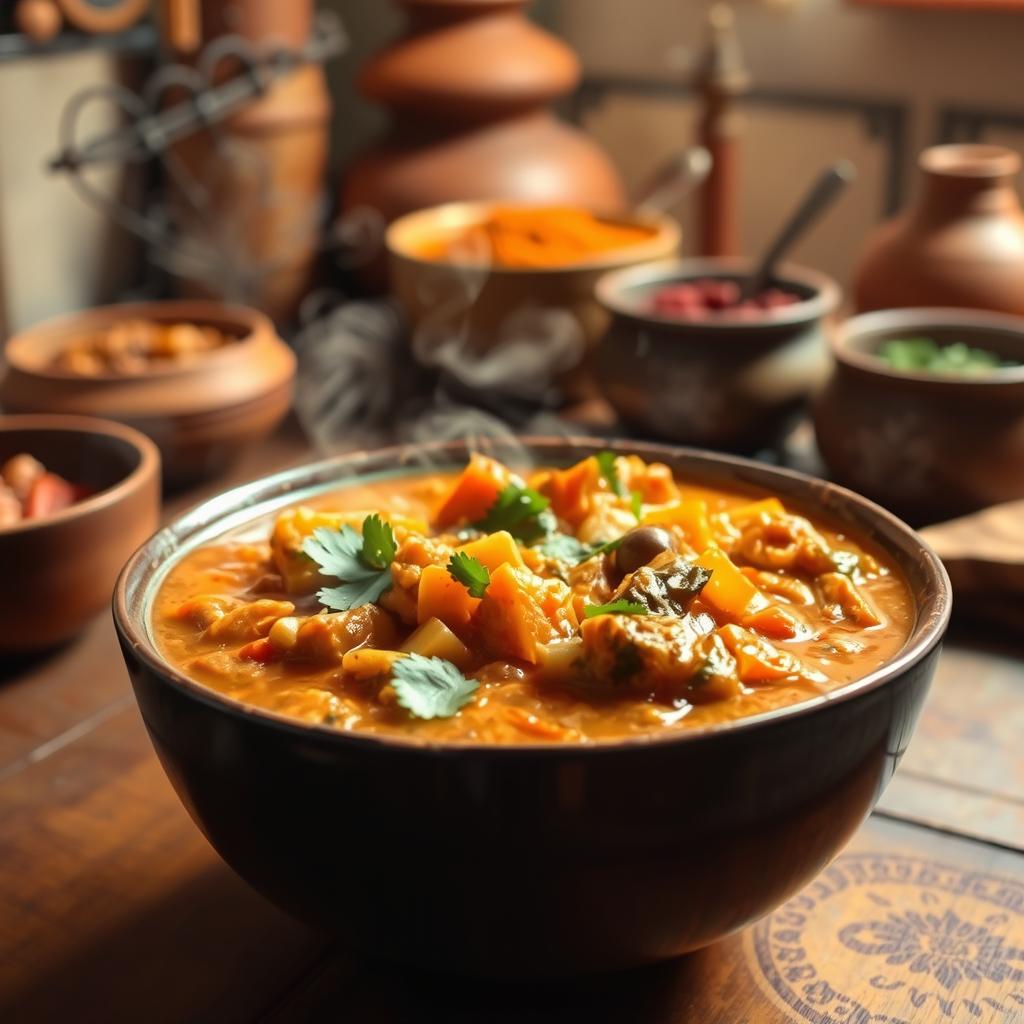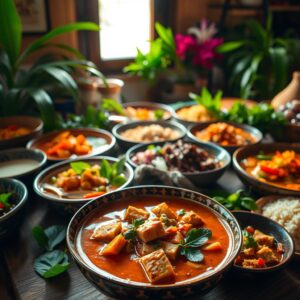vegan indian recipes open a door to bold, regional flavors you can cook at home with confidence.
Can a weeknight meal capture the depth of street food and temple fare without animal products? This guide shows how.
You’ll learn practical tips for pantry staples, like kasoori methi, Kashmiri red chili powder, and hing, and simple techniques such as tempering (tadka) to unlock authentic taste.
From North and South favorites — kanda bhaji, Amritsari kulcha, aviyal, and aloo gobi — to high-protein plates like chana masala and rajma, these plant-centric dishes use cashew cream, coconut milk, and tofu to keep richness intact.
Find trusted guidance and pantry help at Vegan Richa’s collection (Vegan Richa), Serious Eats’ pantry guides (Serious Eats), and top cookbooks like Vegan Richa’s Indian Kitchen.
Key Takeaways
- Start simple: stock spices and basic ingredients to recreate favorite dishes.
- Use tempering and regional techniques to boost flavor quickly.
- Swap dairy with cashew cream, coconut milk, or plant yogurt for richness.
- Pick protein-forward meals like chana masala and tofu tikka masala for balance.
- Adapt recipes for sattvic or fasting days by omitting certain ingredients.
- Plan batch-cook components to make weeknight cooking easier.
Vegan Indian recipes you can cook today: a quick introduction
Pick three starter dishes that give you confidence and show how pantry spices transform simple ingredients.
Start small and win fast. Masoor dal, aloo gobi, and tamarind chutney are perfect first steps. Each one uses common ingredients and simple technique so you get big flavor in little time.
Practice a basic tadka (tempering) to layer aroma and depth. This quick step changes the profile of many indian dishes and takes under a minute once you know how.
Keep fresh aromatics—ginger, green chiles, cilantro—on hand to brighten food with minimal prep. Build a weekly plan: two familiar dishes and one new dish to expand skills without stress.
- Focus on core ingredients: red lentils, potatoes, cauliflower, tomatoes.
- Learn three go-to dishes to speed up grocery runs and meal timing.
- Use step-by-step help from a beginner hub like Vegan Richa’s Indian category.
| Starter Dish | Key Ingredients | Why It’s Fast |
|---|---|---|
| Masoor Dal | Red lentils, turmeric, tomato | Quick to cook; one-pot comfort |
| Aloo Gobi | Potato, cauliflower, cumin | Minimal prep; pan-fry to brown |
| Tamarind Chutney | Tamarind, jaggery, spices | Make-ahead condiment; brightens plates |
Your vegan Indian pantry: spices, staples, and smart dairy swaps
Start with dependable grains, pulses, and a handful of spices so you can build meals fast.
Core staples to stock
Keep lentils, chickpeas, basmati rice, canned tomatoes, and coconut milk on hand so you can make full meals with little notice.
Store a small batch of flours, oil, and soaked cashews for quick sauces. Buckwheat is useful for Ekadasi and fasting days.
Spice must-haves
Small jars of cumin seeds, mustard seed, turmeric, coriander, garam masala, Kashmiri red chili powder, kasoori methi, and hing deliver signature aroma.
Learn to bloom whole versus ground spices. A clear primer is at Serious Eats’ guide.
Dairy-free richness
Blend soaked cashews into a silky cream. Use full-fat coconut milk sparingly for body and whisk plant yogurt into sauces off heat to avoid splitting.
Fresh flavor boosters
Keep ginger, garlic, curry leaves, and green chilies for fast brightness. Freeze extra curry leaves to extend life.
“Kasoori methi, Kashmiri red chili powder, and hing are authenticity boosters that change simple dishes.”
| Item | Use | Storage tip |
|---|---|---|
| Lentils | Quick dals and stews | Cool, dry jar; rotate often |
| Kashmiri red chili powder | Color and mild heat | Small jar away from light |
| Soaked cashews | Silky dairy-free cream | Keep in fridge up to 3 days |
| Curry leaves | Fresh aroma in tadka | Freeze extra leaves in small packs |
Quick and easy vegan Indian recipes for busy weeknights

Short on time? Focus on one-pot dals and fast veg sautés that deliver big taste in under 30 minutes. Plan two simple dishes and a chutney to mix and match across the week.
Masoor Dal — red lentil stew in under 30 minutes
Masoor dal cooks quickly and gives protein with little fuss. Use an Instant Pot to trim time, or simmer on the stovetop until creamy.
Aloo Gobi with pantry spices
Sear potatoes and cauliflower, add cumin and turmeric, and finish with lemon and cilantro for brightness. It pairs well with rice or rotis.
Tamarind chutney — batch and brighten
Make a jar on Sunday. A spoon of tamarind chutney lifts bowls of dal and rice all week.
Tomato-onion dal tadka
Dal tadka is about blooming mustard seeds and cumin in hot oil, then sizzling garlic and chilies. Pour the seasoned oil over dal for instant depth.
Everyday cabbage sabji
Sauté shredded cabbage with mustard seeds, turmeric, and curry leaves. It’s quick, low-effort, and pairs with basmati or pre-made rotis.
“Plan one-pot wins like masoor dal and keep chopped aromatics ready so weeknight food feels effortless.”
| Dish | Key benefit | Quick tip |
|---|---|---|
| Masoor Dal | Fast protein-rich lentil | Use Instant Pot or simmer 20–25 minutes |
| Aloo Gobi | Pantry-friendly veg main | Finish with lemon and cilantro |
| Tamarind Chutney | Sweet-tangy condiment | Batch on weekend; refrigerate |
| Cabbage Sabji | Quick stovetop side | Mustard seeds + curry leaves for aroma |
For step-by-step guidance, follow trusted pages such as Vegan Richa’s dals and sabzis and a tamarind chutney method at Minimalist Baker. Keep pre-measured spices and chopped aromatics to speed every dinner.
High-protein vegan Indian dishes that keep you full
Legume-forward mains are the quickest route to lasting fullness and muscle-friendly macros.
Focus on hearty pulses and firm tofu to build meals that satisfy. Combine a bowl of chana masala over rice or a whole-wheat roti to create a complete protein profile you can rely on for lunch or dinner.
Chana Masala basics
Chana masala shines when chickpeas are simmered until tender and scented with garam masala and kasoori methi. Serve with rice or roti so amino acids complement each other.
Rajma for comfort
Simmer kidney beans until creamy; their natural starch helps thicken the curry. Rajma pairs well with basmati rice and makes excellent meal-prep portions.
Vegan Dal Makhani and Tofu Tikka Masala
Make a vegan dal makhani with black lentils and beans, finished with cashew-coconut for richness without dairy. For a paneer-style option, marinate tofu and grill it into a tikka masala adaptation that keeps texture and heartiness.
“Combine legumes with whole grains and a side of veg to boost satiety and micronutrients.”
- Use a pressure cooker to speed beans and improve texture.
- Season boldly with garam masala, Kashmiri red chili, and kasoori methi for depth without extra oil.
- Prep tip: Portion chana masala and rajma with rice for quick reheat meals.
| Dish | Main Protein | Best Pairing |
|---|---|---|
| Chana Masala | Chickpeas | Rice or whole-wheat roti (complete protein) |
| Rajma | Kidney beans | Basmati rice (comfort bowl) |
| Vegan Dal Makhani | Black lentils + beans | Roti or rice; cashew-coconut finish |
| Tofu Tikka Masala | Tofu | Roti or rice; grilled for firm texture |
For reliable techniques and legume frameworks, consult Vegan Richa’s Indian Kitchen. For evidence-based guidance on plant protein pairings, review Harvard T.H. Chan School’s nutrition pages to plan balanced meals.
Regional favorites: North and South Indian plant-based plates
Taste regional contrast by pairing a North stuffed flatbread with a coconut-scented South curry. These plates show how small swaps and local techniques shift texture and aroma.
North ideas
Amritsari kulcha-inspired flatbreads make a hearty base—stuff them with spiced potatoes or greens for a quick main.
Recreate a plant-forward version of classic butter chicken by using a cashew-coconut sauce and tofu or soy curls to mimic richness without dairy or meat.
South flavors
Explore south indian plates like aviyal and peerkangai kootu. Both lean on coconut and curry leaves for bright, layered aroma. Mustard seeds and tempered spices finish these bowls.
Street snacks and pickles
Bring kanda bhaji and tangy chaats home for crunchy, chatpata bites. Keep a jar of hari mirch ka achar to add heat to mild bowls without upsetting balance.
“Create a mixed thali at home to feel contrast in texture, spice, and aroma.”
- Try a regional round-robin: flatbread + South curry + a pickle.
- Follow a curated regional recipe list: Vegan Richa’s Indian collection.
Comforting curries and gravies you’ll cook on repeat

Start with a flexible sauce framework and you can spin endless curry variations from one batch. A reliable base saves time and keeps weeknight bowls interesting.
Creamy cashew-coconut base you can adapt
Build a master cashew-coconut cream by blending soaked cashews with a touch of coconut milk and cooked onions. Use it as the backbone for vegetables, chickpeas, or tofu.
Balance richness with acidity—add tomatoes or a squeeze of lemon. Finish with kasoori methi for a lifted aroma.
Spinach lover’s palak-style with tofu
For a green gravy, blend spinach until velvety, simmer with garam masala, and fold in pan-seared tofu cubes. Toast whole spices before grinding to elevate aroma and depth.
Stir in plant yogurt off heat for tang and silk. Thin with hot water if you need looser texture.
“Scale and freeze portions; cream-style sauces reheat beautifully with a splash of coconut to restore gloss.”
| Base | Use | Finish |
|---|---|---|
| Cashew-coconut cream | Vegetables, chickpeas, tofu | Kasoori methi + lemon |
| Spinach puree | Palak-style tofu | Garam masala + yogurt off heat |
| Toasted whole spices | Ground for depth | Kashmiri red chili for color |
- Keep salt and oil moderate; let spices and herbs lead flavor.
- Freeze individual portions and revive with a splash of coconut milk.
- Serve with basmati or jeera rice to soak up every bite.
- For a step-by-step palak method, see Vegan Richa’s palak collection: https://www.veganricha.com/category/indian/
Sides, breads, and chutneys to round out your meal
A handful of easy chutneys and a perfectly cooked pot of rice lift every dinner. These small additions balance texture and flavor so your main dishes feel complete.
Fluffy basmati and jeera rice
Rinse basmati rice until the water runs clear, soak briefly, then use the correct water ratio for fluffy grains every time. For jeera rice, bloom cumin in oil, add drained rice, and finish with fresh coriander for aroma.
Every-table chutneys
Blend a bright cilantro-mint chutney, creamy coconut chutney, or savory onion-tomato chutney. Season with roasted cumin, lemon juice, and salt to balance heat and herbaceousness.
“Batch chutneys—they keep in the fridge and make leftovers sing.”
Roti and paratha basics
Practice roti with proper hydration and rest; roll evenly and cook on a hot tawa for puff and softness. For flaky parathas, brush oil between folds and pan-fry until golden.
Pair saucy curries with rice and drier sabzis with roti. For a detailed, step-by-step roti tutorial, follow this guide: Cook with Manali — Homemade Whole Wheat Rotis.
Time-savers, tools, and trusted resources
Cut your weeknight cooking time by pairing a few reliable tools with smart habits. You’ll keep depth of flavor while shaving active time.
Instant Pot advantages for dals, beans, and curries
The Instant Pot shortens simmer time and gives consistent texture for lentils and beans. Pressure cooking hydrates legumes thoroughly and often removes the need to soak.
Use it for one-pot stews, pressure tests for firm tofu curries, and to reduce active monitoring when you are busy. It also saves water by locking in steam.
Cookbooks and blogs to follow: explore more vegan Indian recipes
Keep a few trusted sources bookmarked so you can pull a reliable recipe fast.
- Vegan Instant Pot Cookbook — 150 global and Indian recipes: https://www.veganricha.com/instantpot-cookbook/
- Vegan Richa’s Indian Kitchen for fundamentals and regional techniques: https://www.veganricha.com/vegan-richas-indian-kitchen/
- Short how-to videos and quick demos: https://www.youtube.com/veganricha
“Batch-cook base sauces and freeze portions so any recipe becomes a quick assembly job on weeknights.”
| Tool | Use | Why it saves time |
|---|---|---|
| Instant Pot | Dals, beans, one-pot curries | Fast, consistent pressure cooking |
| Heavy-bottom pot | Slow sauce simmer | Even heat, less sticking |
| Tawa & spice grinder | Breads and toasted masalas | Quick finishing and fresher flavors |
Quick tip: Keep a bookmarks folder labeled by indian dishes so you can find a go-to recipe in seconds.
Simple Weekly Plan to Master Vegan Indian Recipes
Finish with a simple plan: pick one new curry, one reliable rice or roti method, and one chutney to master each week. This steady practice turns unfamiliar techniques into easy habits and builds confidence in cooking.
Focus on flavor foundations: keep core spices like kasoori methi and Kashmiri red chili powder on hand, use cashew cream or coconut milk for silky gravies, and pair lentils or chickpeas with rice to make complete meals.
When you want comfort, try a plant-based dal makhani or a tofu take on butter chicken. For more how-to guides and tested recipes, visit Vegan Richa’s Indian collection and Serious Eats’ Indian guides. Keep notes, adjust water and salt, and enjoy the learning curve.




